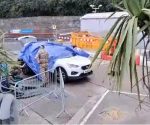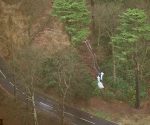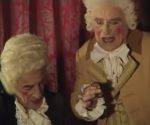Two hats and a funeral; Part Two – featuring the drill-gone-live explanation
In the first part of this series we examined a grouping of data from two eye-witnesses, given independently of each other to corporate-media, which agreed to one particular version of the attack on Jo Cox. In this part we look at another version that is mainly constructed from the testimony to court, in the trial of Thomas Mair, the man since convicted of murdering Jo Cox, of her political associates who had been accompanying her at the time of the attack. Rather fortunately, some of this data was collected and reported (here and here) by Nick Kollerstrom who attended the trial, and thus, because it had been omitted by corporate-media, was saved from oblivion. All of this information tells of an attack by someone wearing different items of clothing than told of in the other version of events, and relegates the idea of an intervening have-a-go-hero to something between a minor footnote and an invention. In this second version too, the attacker is said to make political statements (we’ll examine the trial testimony of all the people who said they heard these utterances – and show that there are very good reasons not to trust it). To conclude the series, and drawing everything together, an explanation for the antagonism of detail in the story of Jo Cox’s death will be contemplated: e.g. that a drill – a practice exercise – was happening simultaneously. Drills that sit underneath real events are a feature that recorders of State Crime have come to expect to see in a false flag attack, and this is what the Jo Cox incident appears to the author to be.
Sandra Major was Jo Cox’s senior caseworker. The following is the fullest account of her trial testimony that the author can find. In fact, this account is the only occasion when Sandra Major’s account hadn’t been broken into snippets and randomly distributed about many articles. This fragmentation of information is a feature of the reporting of the Jo Cox case. It may reflect the eratic and giddy minds of the generation now writing for corporate-media, but it actively prevents a reader gaining an appreciative grip on what should be a very simple timeline of a series of actions. The effect produced is one whereby a reader can only obtain an abstract general impression of what happened. If it’s not deliberate, the style of the corporate-media is very handy for its purposes.
Sandra Major had the clearest view of the beginning of the deadly attack. She had got out of the car’s front passenger seat and walked a few paces ahead of Jo and Fazila Aswat. She told a hushed courtroom: “In my peripheral vision I saw a man walking past me. He had a gun in his hand, he raised his arm and he shot Jo in the head … in the area of the temple.
“She fell back onto the ground and there was blood pouring down her face. He said something along the lines of ‘keep Britain independent’ or ‘British independence’.”
Mrs Major described the gun as being “short, it wasn’t a shotgun, but it was quite deep”. She said she thought Mair had a shopping bag in his left hand with the gun in his right. He got a knife out of the bag. It was black. Jo was lying on the floor and she sort of tried to push herself up using her right arm but he just started stabbing while she was lying on the floor. He was stabbing her.
“Fazila was in between two parked cars. We started to hit him with our handbags. Fazila said ‘get away from her, she has two little children’. I was just screaming. I thought if people came he might go away.
“Jo could not get up but she did a sideways roll and went into the road. He went towards both of us. We were quite close together. Jo was in the road and she shouted ‘get away you two, get away. Let him hurt me, don’t let him hurt you’.
“He’d started to walk away a few feet but when Jo shouted out he came back. Then he shot her twice more and started stabbing her again. She was on the floor. She did not get up again.”
Mrs Major said that Mair then walked away, down Market Street in the direction of Bradford Road.
(Source).
Like Sandra Major’s trial testimony, that of Fazila Aswat is usually dismantled and thrown haphazardly into several articles. The author found two fuller accounts, and the following is the less clumsy of the two:
Ms Aswat became officer manager and personal assistant to Mrs Cox when she was elected in May 2015.
She described parking the car in the street outside the library shortly before the attack. She said: “I got out of the car and I was stood on the roadside. Jo walked over to the side of the pavement. Sandra, she was already there. In that instant, our lives changed forever. The next thing I saw was Jo was on the floor and this man was stood over her with a knife.”
Ms Aswat started shouting for help, and heard a gun shot and saw Mrs Cox getting stabbed. She said: “I can remember the hand motion, it was really fast, so I cannot say which hand he used.”
Mr Whittam said: “Did you encourage her to run away?”
She replied: “I shouted, ‘Jo, you need to run’.
“After the first part of the incident, the man seemed to be retreating, so I ran back towards Jo. At that time, everything was focuses [sic] on Jo. I said, you need to get up. At that time she was talking – ‘Fazila, I cannot run, I am hurt’.”
Even at that time, she was “so composed”, but unfortunately “he then came back”, she told the court.
Ms Aswat said: “Jo was no longer on the pavement, we were on the road. When he first came back, I was standing over Jo, and I was saying to her, I was referring to her children – ‘just think of X and Y, you need to get up and run’. I started swinging my handbag and he swiped his knife towards me several times – not necessarily to attack me but to get me away from Jo, because he wanted to get her again.”
She said she then heard a further two gunshots, and saw him stabbing Mrs Cox again.
Asked if he said anything during he attack, she told the court: “Not during the attack, it was at the very end. He stood up and said, ‘Britain first’.” [Also ‘Britain first, Britain will always come first’ in another article].
He then left the scene and headed down the road, she told the court.
She added: “Jo was in my arms. It probably took about three or four minutes for the police and ambulance to arrive. But at that moment, it felt like a lifetime.”
(Source).
Let’s notice what is common to both accounts. The first act of the attack was one in which the assailant knifed Cox as she was lying down on the pavement. The method by which Cox was floored appears to have been the first gun shot. Aswat didn’t see the gun being raised, but heard it being fired (yes, the journalism does suggest that she started screaming before this, but it’s likely just bad writing). Then the two women seem to have been able to get themselves between Cox and her assailant so that they could hit him with handbags – Aswat puts this down to an opportunity arising by his having retreated a little. Jo Cox, in the meantime, had moved from the pavement into the road – Major says that this was done by the execution of a sideways roll. Aswat implies that there was a second time that the assailant walked away and returned; Major explicitly states it, and we discover that the second return to the victim was actually triggered by further shouting by Jo Cox herself (which is a very interesting detail). At this point the assailant shot Cox twice, and then stabbed her some more. When the attack had concluded, the assailant escaped down Market Street. The only big difference, on first impression, between the accounts appears to be that Major says that the assailant made his political statements at the start of the assault, and Aswat says that he made them at the end. However, we are also fed another grain of information in another place (here) that Major is meant to have stated that at the end of the assault “[Cox] was on the floor. She didn’t get up again. He was still shouting and shouting”.
Conspicuous by its absence in either of the accounts was the notion of any intervention by a have-a-go-hero. Now, this sort of thing could have been the cause of at least one of the retreats made by the assailant, but why is it not mentioned? Did the court reporting make the omission, or did the witnesses? The author was able to find one exceedingly significant fragment of information relating to Fazila Aswat’s testimony that does indeed betray at least one omission of vital data made by court reporting. Here it is:
In cross examination, Mr Russell-Flint simply asked Mrs Aswat a few details about the attacker’s appearance and clothing. As she left the witness stand she looked straight at Mair in the dock. He maintained his blank stare, straight ahead.
Let’s not be of any doubt, this paragraph is designed to make it look as though Fazila Aswat recognises the man in the dock, supposedly one Thomas Mair of Birstall, as the attacker, so something very important has cunningly been used in a casual way to relate another message to the reader. That real vital thing of importance is that demonstrated here is proof that Aswat was asked about the appearance of the suspect when he supposedly killed Cox. Aswat did answer – we know this because of Nick Kollerstrom – but apparently she didn’t speak in a way that was acceptable for the narrative, and we’ll deal with this shortly. Firstly, let’s appreciate that at no time were any of the witnesses in court asked to identify Mair as the person who was seen killing Jo Cox, and again we can thank Kollerstrom for the fact that we know this. Let’s be clear, trial witnesses could be talking about a different person altogether if they don’t identify the suspect in the trial as the object of their testimony, and anyone receiving the information would naturally ascribe the actions described to the person they had been told to believe was the suspect. So, with this extract, the writer is urging the reader to form this connection of positive identification for themselves. It is only to be expected from state-controlled corporate-media looking to deceive its audience.
Now, returning to Aswat’s concealed answer. According to Kollerstrom (who is presumably paraphrasing), this was as follows:
The fellow was 5’ 10” high, in his late 50s, with white silvery hair over his head and ears, wore a dark baseball cap and had a blue rucksack.
Not only that, Kolllestrom recorded what was said by Sandra Major regarding this matter:
He had a black or blue baseball cap, and was wearing a shirt and tie.
(Source).
Perhaps not surprisingly, that Cox was attacked by a man wearing a dark cap does not appear in any corporate-media reporting that the author has looked at. Kollerstrom is not inventing this information. That the assailant was wearing a black cap has been verified, independently of any court reporting, in an interview by the BBC with a local resident, Sam Watson (see this video). So here is the second version of the attack: a man wearing a black or dark cap who shouts political statements, and who leaves off the attack twice (for unknown reasons) only to return to Jo Cox and continue it.
Finally, there are three points worthy of remark about the testimony by Aswat and Major. Firstly, notice how very strange the idea is that Jo Cox could calmly insert herself vocally into proceedings the way she did. She was shot in the head in the very first instance, at point blank range. The force of the shot knocked her flat onto the pavement. In that state, would she be able to be aware of and comment on the whereabouts and doings of others? Secondly, the testimony confirms that the attack happened almost instantly after the women got out of the car. However, a previous investigation at this site shows that there is no way that a figure shown in CCTV footage who is purported to be Mair could have reached this party of women on time – unless they hung around outside the library to wait for him. That any procrastination did not happen is not ruled out by the testimony, but it certainly would have been odd behaviour for people who were actually due to hold a surgery for the public in a matter of minutes. Thirdly, we shouldn’t forget that Major and Aswat are Labour Party operatives. This case was political, and it remains political. The Labour Party were officially backing Britain remaining in the EU during the campaigning period for the referendum on EU membership, and this incident was exploited politically for engineering emotionally-driven support for that cause.
Moving on to the next person of interest: Rashid Hussain. The corporate-media carried images of a man reported to be Rashid Hussain arriving at court and please note, he appeared to be a bearded man of Asian descent. The following is an example of the more substantial sort of thing that appears on the internet regarding Rashid Hussain’s testimony:
Local taxi driver Rashid Hussain pulled up at around the same time as Mrs Cox’s arrival at Birstall Library in a silver Vauxhall Astra. As he was giving his fare her change, he heard what sounded like a “firecracker”, jurors were told.
Mr Hussain demonstrated in the witness box how the man had stabbed Mrs Cox five or six times in front of him.
He said: “When I reached near, he stepped back. I said: ‘What are you doing? What’s wrong with you?’ He said: ‘Move back, otherwise I’m going to stab you.’ He was standing there with two ladies and another man. He said, ‘Better move back.’ He shot twice. He moved back and shot again.”
Mr Hussain told jurors that by this point Mrs Cox, who he had recognised as his MP, was bleeding and was being helped by an Asian woman. He said: “Jo’s head was in her lap and she was pleading for Jo to stand up, talking about her kids. Her hands and clothes were covered in blood. She was the only person there helping her.”
(Source).
Additionally, other reportage elsewhere includes this snippet of data (source):
Mr Hussain said the man came back and fired two more shots at #JoCox – the man then shouted something, the last words were “Britain first”
So, Hussain agrees with the two women in these most important respects: that the attacker interrupted his attack (Hussain is not clear about how many times), and a political statement was uttered by the attacker (at the end of the attack). Notice, there is no mention of an intervention by a man who subsequently gets injured – the author could not find any instance of Hussain reporting this. However, the reader might have noticed this: “[the attacker] was standing there with two ladies and another man.” The author is at a loss as to what this is supposed to be describing. The two ladies must be Major and Aswat. But who could the other man be? According to the official story, the only person who got near the attacker got stabbed; this was Bernard Kenny, and (especially) for a 77-year-old, this was quite dynamic:
“I jumped out of the car. I thought if I could jump on to the back, I could take him down. I thought he was thumping her until I saw the blood. I saw he had a knife in his hands. Just as I got short of him, he turned around and saw me. He shoved the knife in and it hit me in the stomach. The blood started pouring out between my fingers. I saw the blood and I thought ‘Oh my God.'”
He described staggering away to a nearby sandwich shop, from where he could see the man “going berserk with a knife”.
(Source).
Not a lot of “standing there” going on in any of that lot. In the first part of this series, it was shown that there should be enormous doubt about a man called Bernard Kenny intervening in the event (to the point of understanding that it didn’t happen). Could Hussain be telling us about the real incident?
Elsewhere on the internet, it is revealed that Rashid Hussain was also asked about the appearance of the attacker.
Taxi driver Rashid Hussain now being cross-examined by Thomas Mair’s QC. One question about appearance then witness leaves court.
Unfortunately, Sky’s Andy Hughes, who reported this in a tweet (here), failed to follow up. Again, is this because the attacker appeared to Hussain in a way that would have been contrary to the official narrative? Well, the answer is probably yes. Kollerstrom tells of how most witnesses in court tell of a man in a black or dark hat.
There is a problem with Hussain as a witness, and this is revealed in more tweets by Sky correspondents in court.
Taxi driver Rashid Hussain was in Birstall village on day #JoCox was killed – was taking customer to local Tesco store
Mr Hussain said he saw #JoCox on the street as he pulled up to drop customer off. Said he then heard sound of firing and shouting
(Source).
From this we can ascertain that Hussain is claiming that he saw Cox – pre-attack – as he was pulling up to drop off a customer for Tesco. The Tesco Express in Birstall is on a parallel street – Smithies Lane – and has its own car park. This doesn’t mean that Hussain didn’t pull up on Market Street to drop his fare off – as he must have done to get a visual on Cox – and the usual practice of taxi drivers in Birstall isn’t known by the author, but it occurs that it would be a little odd if Hussain didn’t drop off as close as possible. However, the point really is this: this information should have been tested in court. Hussain should have been asked to clarify, because if he dropped a fare in the car park at Tesco, how did he see Jo Cox outside the library? It is quite acceptable in trials to try to establish that a witness could not in fact see or hear what he or she claims to have seen, and therefore is unreliable. There are lots of reasons why people do invent stories, including having an official narrative override their own impressions. Why wasn’t it tested for in this case?
Now we turn to Jack Foster, another witness who supposedly heard the attacker make a political statement. There isn’t much reporting of this witness; usually his testimony is presented in short and similar terms to this (paraphrasing): “Another witness who heard Mair shout Britain First was Jack Foster” (so it is reported). The following is the most substantial that the author could find.
Jack Foster told the court he saw the man, having shot Ms Cox once, reload his gun before shooting her twice more.
The England fan, who was wearing a red Three Lions football shirt ahead of a Euro 2016 game that evening, told how he shouted “f***ing leave her alone” but he took no notice.
“He reloaded his gun again, putting two cartridges in, cocked it and shot her on the floor,” Mr Foster said.
He told the court he and two other men followed the man into a nearby street.
Mr Foster added: “He casually walked off. No remorse, no nothing.”
(Source).
Has the reader noticed what is wrong with this? It is the claim that the attacker put two cartridges in his weapon, and cocked it. Mair didn’t have a shotgun, which is what Foster is describing. He had a bolt action weapon that took a single round. The priming of the firing pin in such a weapon is performed in the movement of the bolt, the trigger doesn’t need to be cocked. When the bolt closes on an empty breech, one pulls the trigger to discharge the firing pin. So if Foster saw Cox being attacked with a shotgun, he didn’t see Thomas Mair attack her, because Thomas Mair, or so we are told, used a sawn-off bolt action rifle. If Foster was merely badly mistaken about what he witnessed, then why could he not have been badly mistaken about what Mair was supposed to have said that had political significance at a politically sensitive time? Again, the question must be asked, why wasn’t this catastrophic inaccuracy pursued by Mair’s defence?
The only other witness to supposedly hear the attacker make political statements was a woman known as Tracy Bywood, “who was washing up in a care home kitchen overlooking the attack scene when it unfolded” (source). This is the fullest account of her testimony that could be found:
“I saw him wind his hand in her hair and drag her off the pavement,” she said.
“It was horrible what I saw. She went down on the floor like a sack of potatoes. It was awful to see a lady get such animosity.”
She said she was “fairly sure” she heard “someone shout Britain First”.
“He was so peaceful and calm as if he hadn’t done anything wrong,” she said.
She told the jury she heard a “popping noise” and said: “I won’t even buy Pringles any more, I can’t handle the noise of the seal breaking.”
(Source).
It should be noted that the Priestley Care Home is a large complex separated from the crime scene by about 100 feet and a community hall which is nevertheless set back from the road so that a green space does potentially afford a view for anyone looking up Market Street. However, there does appear to be a lot of trees interrupting any vantage point Bywood could have occupied, and it is unquestionably relatively remote from the place of the incident. The problem with the testimony should be self-evident, and the defence counsel should have gone after it. In addition, Bywood says that Cox came to be on the road because she was dragged there by someone pulling her hair. This is not what Cox’s political associates said.
Let’s just accept that Tracey Bywood was able to see the attacker drag Jo Cox into the road by her hair. Why is there such a fundamental discrepancy between this account and Fazila Aswat and Sandra Major’s version of events? In the bigger picture as discussed over two FBEL articles, how do we explain two general versions of events? What begins to suggest itself to the author as a possible explanation is that a drill, or a practise exercise, was scheduled at the very same time as the actual incident took place. Some people on the scene could have been privy to this, and as such would have acted out appropriately to the incident understanding that it wasn’t real, but that they must react to it as if it was. These people would be working to a script, and this authoritative version (when the incident was being recalled) would override any deviation that might have occurred after the incident had gone live – meaning, the real life “murder” was allowed to run its course (more on this in a moment). People who were not privy to this script would simply report what they had seen. They might also, after the fact, start to repeat elements of the official script (which would be presented in corporate-media or introduced on the ground by operatives) as they lose confidence in the certainty of their own experience.
When a drill goes live, the perpetrator, who would previously merely only have pretended to commit the offense around which the drill is organised, actually turns into a real offender and commits a real offence. The drill actors, after having played their parts according to a script, would be told at the end of the event that there was a real incident after all, and would probably be hemmed in contractually (or by threats) from discussing the process that they had been a party to – as much of it that they could understand. As the perpetrator would be a proxy for the State Criminal, and as such undiscoverable, there would have to be a patsy to take the fall for the crime. Subsequently, witnesses would report seeing the perpetrator and also the patsy – who would, by some ruse or other, be made to be entangled in proceedings to such an extent that witnesses could easily be persuaded into thinking that he was the one and only actual offender. In the Jo Cox incident, Thomas Mair, living alone as he did (and thus making it easy for police to plant evidence at his home) and having mental illness so that, left alone, he could not begin to unpick himself from his entanglements, would have been a perfect patsy.
In the case of the Jo Cox incident, where a body could not be produced as evidence to a jury in a murder trial, there is a case to make that the pretend murder aspect of the drill was not changed, and it remained pretend – i.e. it was a hoax rather than a false flag. Only Jo Cox, the perpetrator, and the “emergency services” that first dealt with her would be knowledgable of this scenario. Other drill actors would still be told that something went wrong, and that there had been a real murder after all. The patsy is always in the dark. There is evidence that this could have happened. Consider how Twitter user “ScotsFootyCards” in Birstall took imagery on 13:07 and 13:08 that showed ambulance and police approaching Smithies Lane, so at this point the the incident was 15 minutes old. Fazila Aswat, however, reported that it had taken three or four minutes for the police and ambulance to arrive, presumably, from the context of her testimony, after the attacker had made his escape. If there is CCTV footage of the attacker fleeing the scene at 12:53, then we’re looking at the arrival of police – but more significantly an ambulance, which is meant to await police clearance to enter a crime scene – according to Fazila Aswat, at about 12:56-12:58. Theoretically, this could be the cover-up squad arriving ahead of the real response.
At the top of this it was mentioned that this article rounds off a two-part series. However, there will be one more on the subject of Jo Cox appearing at this site that examines the hypothesis that what happened on June 16th 2016 was the culmination of a long term plan to sway voters to choose Remain in the EU Referendum.
A note on video evidence shown at the trial
Nick Kollerstrom reported that the footage shown to the court was barely visible from the public gallery. “Lots of other CCTV was shown, in none of which I could recognize him [Mair], but someone with a white cap was bobbing around. Other visitors I spoke to (tho [sic] you’re not supposed to) did not see anything much in these videos.”
This CCTV footage is undoubtedly recorded by the same camera that filmed footage of Market Street that has made public by West Yorkshire Police, and which is purported by police to show Mair making his escape. In this footage it is very hard to see what is happening behind the fleeing figure back at the scene of the crime. The author suggests that there is no way that anyone looking at this film could distinguish facial features that could inform them that Thomas Mair had been the perpetrator of a crime, or indeed what any crime actually constituted.


















